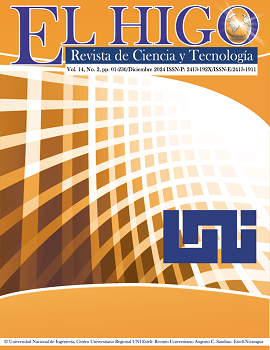Historical evolution and current challenges of occupational hygiene and safety in Nicaragua
DOI:
https://doi.org/10.5377/elhigo.v14i2.19657Keywords:
Job security, Labor regulations in Nicaragua, Law 618Abstract
This study analyzes the historical evolution of occupational safety in Nicaragua, examines the national regulatory framework (Law 618) and proposes strategies to face current challenges in occupational hygiene and safety. Its relevance lies in the urgent need to improve safety in the workplace, which would contribute to reducing the risks of occupational diseases and accidents, thus improving the health and well-being of workers. The methodological approach used is qualitative, allowing an in-depth analysis of the phenomena related to occupational hygiene and safety, as well as legal aspects in Nicaragua. Through qualitative methods such as content analysis, advances in workplace safety legislation and practices in the country were identified. The findings show that Nicaragua has made progress in industrial safety, aligning with international standards such as ISO 45001 and ILO guidelines. Law 618 of 2007 has been fundamental in improving job security, although challenges persist in its implementation, especially in informal sectors and small businesses due to lack of resources and training. At a global level, continuous training, the use of digital platforms and the strengthening of oversight are crucial to optimize industrial safety. It is recommended to continue improving prevention policies and promote a culture of workplace safety in Nicaragua. continue to improve prevention policies and promote a culture of workplace safety in the country.
Downloads
1177
References
Arias Gallegos , W. L. (2012). Revisión historica de la salud ocupacional y la seguridad industrial. Revista Cubana de Salud y Trabajo, 45-52.
Asamblea Nacional . (30 de Octubre de 1996). Codigo del Trabajo. La Gaceta.
Asamblea Nacional de Nicaragua. (13 de Julio de 2007, 19 abril). Ley 618 Ley General de Higiene y Seguridad del Trabajo. Managua: La Gaceta. Obtenido de http://legislacion.asamblea.gob.ni: http://legislacion.asamblea.gob.ni/Indice.nsf/118df5a71dbb4fbb06257214005a9e04/bab4f1580d7884df06257352006ceaaa?OpenDocument&Highlight=2,618
Chiavenato , I. (2007). Introducciòn ala Teoria General de la Administraciòn. Mc Graw Hill.
Chiavenato, Idalberto. (2009). Gestiòn del Talento Humano. Mc Graw Hill.
Cornejo Paz , R. R., Araúz López , I. O., & Cruz Zeledón , E. (Abril de 2019). Influenia de las condiciones de higiene y seguridad ocupacional en el desempeño de los servidores públicos de la municipalidad de la Concordia, Periodo 2018. Obtenido de https://repositorio.unan.edu.ni: https://repositorio.unan.edu.ni/11418/1/20113.pdf
Jiménez Leen , J. M. (2017). Historia de la Salud Ocupacional en la Dinamica del docente. Revista Arbitrada Interdisciplinaria, 48-64.
Legislación. (s.f.). Obtenido de http://legislacion.asamblea.gob.ni/gacetas/2007/7/g133.pdf
MITRAB. (1 de Septiembre de 1993). http://legislacion.asamblea.gob.ni. La Gaceta No 165, pág. 878. Obtenido de http://legislacion.asamblea.gob.ni: http://legislacion.asamblea.gob.ni/Normaweb.nsf/0/071181C1ACA31B16062570A10058502F?OpenDocument
MITRAB. (Marzo de 2008). https://oiss.org/wp-content/uploads/2018/11/1Compendio_normativo_Hig_Seg_Nicaragua.pdf. Obtenido de https://oiss.org: https://oiss.org/wp-content/uploads/2018/11/1Compendio_normativo_Hig_Seg_Nicaragua.pdf
Oviedo , Q. R., Defranc Balanzategui , P., & Otero , G. T. (2018). Seguridad y salud laboral: una revisión en el contexto actual, a propósito de la nueva ISO 45.001. Revista cientifíca Dominio de las Ciencias, 239-256.
OIT, O. I. (16 de octubre de 2023). https://www.ilo.org. Obtenido de https://www.ilo.org/: https://www.ilo.org/americas/temas/salud-y-seguridad-en-trabajo/lang--es/index.htm
Sevilla, P. (2020). https://economipedia.com/definiciones/piramide-de-maslow.html.
Downloads
Published
How to Cite
Issue
Section
License
Copyright (c) 2024 Universidad Nacional de Ingeniería

This work is licensed under a Creative Commons Attribution-NonCommercial-NoDerivatives 4.0 International License.
All material published in the journal is shared under the Creative Commons Attribution-NonCommercial-NoDerivatives 4.0 License. Copying and redistribution of the material in any medium or format is permitted as long as explicit credit is given to the journal, the author and the work, it is distributed free of charge and without modification to the content.











